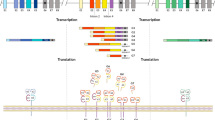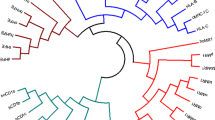Abstract
The hallmark of the classical major histocompatibility complex (MHC) class I molecules is their astonishing level of polymorphism, a characteristic not shared by the nonclassicalMHC class I genes. A distinct family ofMHC class I genes has been recently identified within the humanMHC class I region. TheMICA (MHC classI chain-relatedA) gene in this family is a highly divergent member of theMHC class I family and has a unique pattern of tissue expression. We have sequenced exons encoding the extracellular α1, α2, and α3 domains of theMICA gene from twentyHLA homozygous typing cell lines and four unrelated individuals. We report the identification of eleven new alleles defined by a total of twenty-two amino acid substitutions. Thus, the total number ofMICA alleles is sixteen. Interestingly, a tentative superimposition ofMICA variable residues on theHLA-A2 structure reveals a unique pattern of distribution, concentrated primarily on the outer edge of the MICA putative antigen binding cleft, apparently bordering an invariant ligand binding site.
Similar content being viewed by others
References
Anasetti, C., Etzioni, R., Petersdorf, E. W., Martin, P. J., and Hansen, J. A. Marrow transplantation from unrelated volunteer donors.Annu Rev Med 46: 169–179, 1995
Bahram, S., Bresnahan, M., Geraghty, D. E., and Spies, T. A second lineage of mammalian major histocompatibility complex class I genes.Proc Natl Acad Sci USA 91: 6259–6263, 1994
Bahram, S., Mizuki, N., Inoko, H., and Spies, T. Nucleotide sequence of the human MHC class IMICA gene.Immunogenetics 44: 80–81, 1996
Bahram, S. and Spies, T. Nucleotide sequence of a humanMHC class IMICB cDNA.Immunogenetics 43: 230–233, 1996
Bjorkman, P. J. and Parham, P. Structure, function, and diversity of class I major histocompatibility complex molecules.Annu Rev Biochem 59: 253–288, 1990
Brewerton, D. A., Hart, F. D., Nicholls, A., Caffrey, M., James, D., and Sturrock, R. Ankylosing spondylitis and HL-A27.Lancet 1, 904–907, 1973
Chesebro, B., Miyazawa, M., and Britt, W. J. Host genetic control of spontaneous and induced immunity to Friend murine retrovirus infection.Annu Rev Immunol 8: 477–499, 1990
Dausset, J. and Svejgaard, A. (eds.):HLA and Disease, pp. 316. Munksgaard, Copenhagen, 1977
Degli-Esposti, M. A., Abraham, L. J., McCann, V., Spies, T., Christiansen, F. T., and Dawkins, R. L. Ancestral haplotypes reveal the role of the central MHC in the immunogenetics of IDDM.Immunogenetics 36: 345–356, 1992a
Degli-Esposti, M. A., Andreas, A., Christiansen, F. T., Schalke, B., Albert, E., and Dawkins, R. L. An approach to the localization of the susceptibility genes for generalized myasthenia gravis by mapping recombinant ancestral haplotypes.Immunogenetics 35: 355–364, 1992b
Elder, J. T., Nair, R. P., Guo, S. W., Henseler, T., Christophers, E., and Voorhees, J. J. The genetics of psoriasis.Arch Dermatol 130: 216–224, 1994
Fischer Lindahl, K., Hermel, E., Loveland, B. E., and Wang, C. R. Maternally transmitted antigen of mice: a model transplantation antigen.Annu Rev Immunol 9: 351–372, 1991
Flaherty, L., Elliott, E., Tine, J. A., Walsh, A. C., and Waters, J. B. Immunogenetics of the Q and TL regions of the mouse.Crit Rev Immunol 10: 131–175, 1990
Geraghty, D. E. Structure of the HLA class I region and expression of its resident genes.Curr Opin Immunol 5: 3–7, 1993
Hasan, A., Fortune, F., Wilson, A., Warr, K., Shinnick, T., Mizushima, Y., van der Zee, R., Stanford, M. R., Sanderson, J., and Lehner, T. Role of γδ T cell in pathogenesis and diagnosis of Behçet's disease.Lancet 347: 789–794, 1996
Hill, A. V., Yates, S. N., Allsopp, C. E., Gupta, S., Gilbert, S. C., Lalvani, A., Aidoo, M., Davenport, M. and Plebanski, M. Human leukocyte antigens and natural selection by malaria.Philos Trans R Soc Lond B Biol Sci 346: 379–385, 1994
Hughes, A. L. and Nei, M. Pattern of nucleotide substitution at major histocompatibility complex class I loci reveals overdominant selection.Nature 335: 167–170, 1988
Imani, F. and Soloski, M. J. Heat shock proteins can regulate expression of the Tla region-encoded class Ib molecule Qa-1.Proc Natl Acad Sci USA 88: 10475–10479, 1991
Ito, K., Van Kaer, L., Bonneville, M., Hsu, S., Murphy, D. B., and Tonegawa, S. Recognition of the product of a novel MHC TL region gene (27b) by a mouse gamma delta T cell receptor.Cell 62: 549–561, 1990
Kaslow, R. A., Carrington, M., Apple, R., Park, L., Munõz, A., Saah, A. J., Goedert, J. J., Winkler, C., O'Brien, S. J., Rinaldo, C., Detels, R., Blattner, W., Phair, J., Erlich, H., and Mann, D. L. Influence of combination of human major histocompatibility complex genes on the course of HIV-1 infection.Nat Med 2: 405–411, 1996
Kaufmann, S. H. E. γ/δ and other unconventional T lymphocytes: what do they see and what do they do?Proc Natl Acad Sci USA 93: 2272–2279, 1996
Kaliyaperumal, A., Falchetto, R., Cox, A., Dick II, R., Shabanowitz, J., Chien, Y.-H., Matis, L., Hunt, D. F., and Bluestone, J. A. Functional expression and recognition of nonclassical MHC class I T10b is not peptide-dependent.J Immunol 155: 2379–2386, 1995
Klein, J.Natural History of the Major Histocompatibility complex. pp. 775, John Wiley & Sons, New York, 1986
Klein, J. and O'hUigin, C. MHC polymorphism and parasites.Phil Trans R Soc Lond B 346: 351–358, 1994a
Klein, J. and O'hUigin, C. The conundrum of nonclassical major histocompatibility complex genes.Proc Natl Acad Sci USA 91: 6251–6252, 1994b
Mizuki, N., Ohno, S., Sato, T., Ishihara, M., Miyata, S., Nakamura, S., Naruse, T., Mizuki, H., Tsuji, K., and Inoko, H. Microsatellite polymorphism between the tumor necrosis factor and HLA-B genes in Behçet's disease.Hum Immunol 43: 129–135, 1995
Moriwaki, S., Korn, B. S., Ichikawa, Y., van Kaer, L., and Tonegawa, S. Amino acid substitutions in the floor of the putative antigen-binding site of H-2T22 affect recognition by a gamma delta T-cell receptor.Proc Natl Acad Sci USA 90: 11396–113400, 1993
Nataraj, C., Brown, M. L., Poston, R. M., Shawar, S. M., Rich, R. R., Fischer, Lindahl, K., and Kurlander, R. J. H2-M3Wt-restricted,Listeria monocytogenes-specific CD8 T cells recognize a novel, hydrophobic, protease-resistant, periodate-sensitive antigen.Int Immunol 8: 367–378, 1996
Pamer, E. G., Bevan, M. J., and Fischer Lindahl, K. Do nonclassical, class Ib MHC molecules present bacterial antigens to T cells?Trends Microbiol 1: 35–38, 1993
Parham, P. Antigen presentation by class I major histocompatibility complex molecules: A context for thinking about HLA-G.Am J Reprod Immunol 34: 10–19, 1995
Parham, P. and Ohta, T. Population biology of antigen presentation by MHC class I molecules.Science 272: 67–74, 1996
Schild, H., Mavaddat, N., Litzenberger, C., Ehrich, E. W., Davis, M. M., Bluestone, J.A., Matis, L., Draper, R. K., and Chien, Y. H. The nature of major histocompatibility complex recognition by gamma delta T cells.Cell 76: 29–37, 1994
Schlosstein, L., Terasaki, P. I., Bluestone, R., and Pearson, C. M. High association of an HL-A antigen, W27, with ankylosing spondylitis.N Engl J Med 288: 704–706, 1973
Shawar, S. M., Vyas, J. M., Rodgers, J. R., and Rich, R. R. Antigen presentation by major histocompatibility complex class 1-B molecules.Annu Rev Immunol 12: 839–880, 1994
Strominger, J. L. The gamma delta T cell receptor and class Ib MHC-related proteins: enigmatic molecules of immune recognition.Cell 57: 895–898, 1989
Stroynowski, I. Molecules related to class I major histocompatibility complex antigens.Annu Rev Immunol 8: 501–530, 1990
Townsend, A. and Bodmer, H. Antigen recognition by class I-restricted T lymphocytes.Annu Rev Immunol 7: 601–624, 1989
Trowsdale, J. Genomic structure and function in the MHC.Trends Genet 9: 117–122, 1993
Tsuji, K., Aizawa, M., and Sasazuki, T.HLA 1991. Proceedings of the Eleventh International Histocompatibility Workshop and Conference, Vol 1, pp. 1220, Oxford University Press, Oxford, 1992
Ulbrecht, M., Kellermann, J., Johnson, J. P. and Weiss, E. H. Impaired intracellular transport and cell surface expression of nonpolymorphic HLA-E: evidence for inefficient peptide binding.J Exp Med 176: 1083–1090, 1992
Wu, T. T. and Kabat, E. A. An analysis of the sequences of the variable regions of Bence Jones proteins and myeloma light chains and their implications for antibody complementarity.J. Exp Med. 211–250, 1970
Author information
Authors and Affiliations
Additional information
The nucleotide sequence data reported in this paper have been submitted to the EMBL/GenBank nucleotide sequence databases and have been assigned the accession numbers U56940 (MICA001), U56941 (MICA002), U56942 (MICA003), U56943 (MICA004), U56944 (MICA005), U56945 (MICA006), U56946 (MICA007), U56947 (MICA008), U56948 (MICA009), U56949 (MICA010), U56950 (MICA011), U56951 (MICA012), U56952 (MICA013), U56953 (MICA014), U56954 (MICA015), and U56955 (MICA016)
Rights and permissions
About this article
Cite this article
Fodil, N., Laloux, L., Wanner, V. et al. Allelic repertoire of the humanMHC class IMICA gene. Immunogenetics 44, 351–357 (1996). https://doi.org/10.1007/BF02602779
Received:
Revised:
Issue Date:
DOI: https://doi.org/10.1007/BF02602779




